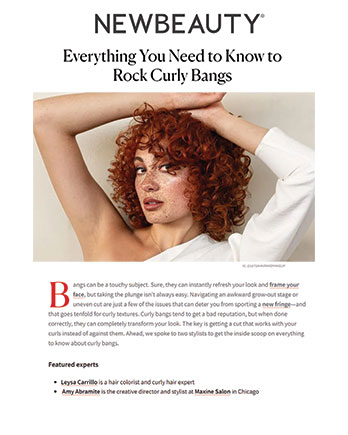New Beauty October 9, 2024
 NewBeauty
NewBeauty
Hair
Everything You Need to Know to Rock Curly Bangs
Plus, five of the most popular styles.
Bangs can be a touchy subject. Sure, they can instantly refresh your look and frame your face, but taking the plunge isn’t always easy. Navigating an awkward grow-out stage or uneven cut are just a few of the issues that can deter you from sporting a new fringe—and that goes tenfold for curly textures. Curly bangs tend to get a bad reputation, but when done correctly, they can completely transform your look. The key is getting a cut that works with your curls instead of against them. Ahead, we spoke to two stylists to get the inside scoop on everything to know about curly bangs.
Featured experts
- Leysa Carrillo is a hair colorist and curly hair expert
- Amy Abramite is the creative director and stylist at Maxine Salon in Chicago
What to expect with curly bangs
Getting bangs of any sort requires some research. However, when it comes to curly textures, it’s essential to find someone well-versed in textured hair. “Finding a stylist or professional who is familiar with curly hair” is essential, says Leysa Carrillo, hair colorist and curly hair expert. Having a consultation ahead of time will ensure that your bangs fit with your curl pattern and have an effortless look. That said, it’s a good idea to bring pictures and to be realistic about what can be achieved with your texture. “Make sure the inspiration pictures match reality when it comes to the curl type and density,” says Carrillo.
What to ask for at the salon
For curly hair, Carrillo notes that a dry cut will always be best. When you’re headed to the salon, she suggests asking your stylist to cut dry and trim the hair gradually for control. The last thing you want is to end up with an uneven fringe due to longer or shorter curls. “With curly bangs, I like to leave them about three inches longer than desired so that we can customize the look throughout the process,” says Carrillo.
The best kinds of bangs for curly hair
Wispy Bangs
Wispy bangs are a great option for a low-maintenance look. Unlike a full bang, this look uses just a few curls to give the hair a fringy feel. To style these bangs, Carrillo says that investing in a good diffuser will go a long way. “You can add fullness without bulk by diffusing the curls instead of crunching them together with product. This gives them a nice, natural bounce and keeps them looking light and airy,” she says.
Curtain Bangs
Curtain bangs have solidified their spot as one of the most popular styles of bangs. Versatility is one of the main reasons they are so beloved. “This style looks great on almost anyone and adds some nice volume around the face,” says creative director and stylist at Maxine Salon in Chicago, Amy Abramite. The key to these bangs is varying lengths. “The hair in the middle should be cut shorter, maybe slightly below the eyebrow, and then gradually get longer on the sides,” she says.
Bitty Bangs
Micro bangs are often paired with straight hair, but Abramite notes that they work just as well with curls. “These are for those who want light, wispy bangs and a fun style that can easily adapt to their current look,” she says. To get the look, she recommends having your stylist separate your curls first and then snipping them above the eyebrows. “This will add detail and soften the forehead,” she adds.
Full Fringe
When styling your bangs, Carrillo notes that it’s important to be aware of the natural fall of the curls around the hairline. “When using products on your bangs, be sure to apply in sections to add bounce to the curls and keep the bangs from looking too flat,” she says. Her pro tip? Apply a hydrating cream like Redken’s Hydrating Curl Cream ($32) to wet hair to define the curls and give them a full look.
Subtle Bangs
This sparse look may be new, but it’s quickly becoming a popular choice at salons. Celebrity hairstylist Valery Joseph recently told NewBeauty that though the trend is similar to curtain bangs, there’s a distinct difference between the two. He explains that these bangs tend to be shorter than a curtain style, making them easy to tuck behind the ears and style.
